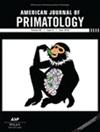Is Extended Lactation Nutritionally Important for the Weaning of Wild Toque Macaques, Macaca sinica? Evidence From Milk Composition
Abstract
Successful lactation is important to offspring survival in wild primates, both during infancy and the transition of weaning. We examined changes in the composition of milk of wild toque macaques to assess its nutritional role both during primary lactation (< 7 mo) and subsequent infant care. We collected 72 milk samples from wild toque macaques (Macaca sinica) in Polonnaruwa, Sri Lanka, up to an infant age (iAge) of 2.2 y and assayed them by standard methods as developed at the Smithsonian's National Zoo. During the first 7 mo M. sinica milk contained on average 86.1% water, 13.9% dry matter, 4.25% fat, 1.62% protein, 7.84% sugar, 0.792 kcal/g energy, 0.083% calcium, 0.026% phosphorus, 0.012% magnesium, 3.32 ppm zinc, 18.1 mM/kg H2O sodium, 4.01 mM/kg H2O potassium and 16.2 mM/kg H2O chloride. Dry matter, fat, and energy increased significantly during this period, but much greater changes were observed in these and other constituents (including protein, phosphorus, and zinc) during the subsequent supplemental lactation period. The average water (74.0%), and sugar (6.31%) decreased, whereas dry matter (26.0%), fat (15.9%), protein (3.8%), energy (1.91 kcal/g), phosphorus (0.050%) and zinc (11.9 ppm) concentrations of M. sinica milk during the supplemental period are higher than any prior reported values for primate milks. As infants aged and transitioned to independent feeding the nutrient composition of milk changed by reducing water and sugar that older nursing offspring obtained progressively more from water and fruit in the environment, rather than from milk. We hypothesize that this switch in sourcing water and sugar conserves maternal energy, nutrient balance, and fitness. Notwithstanding, supplemental lactation continued to provide other nutrients (including fat, protein, energy, P, and Zn) that may serve an important nutritional/developmental function over and above maintenance of maternal-infant bonds, at least in wild primates.


 求助内容:
求助内容: 应助结果提醒方式:
应助结果提醒方式:


